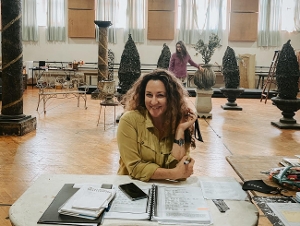Interview: Movement Director Fiona Du Plooy Talks About Bringing TOSCA to life
TOSCA is presented by Cape Town Opera at the Artscape Opera House this September

 After a stellar debut season at the Joburg Theatre, TOSCA is coming to the Artscape Opera House this September. This production from Cape Town Opera is directed by Magdalene Minnaar and conducted by Bjorn Bantock. The directorial team also includes Fiona Du Plooy as Movement Director, and she took some time out to chat to us about her role in the production and the production itself.
After a stellar debut season at the Joburg Theatre, TOSCA is coming to the Artscape Opera House this September. This production from Cape Town Opera is directed by Magdalene Minnaar and conducted by Bjorn Bantock. The directorial team also includes Fiona Du Plooy as Movement Director, and she took some time out to chat to us about her role in the production and the production itself.
BWW: Tell us about your background and how you got into working with Cape Town Opera?
Fiona: For me, the role of Movement Director is a multilayered one. Firstly, it is about understanding the Director's vision and collaborating to co-create the physicality of Opera; to create the movement language and style within the staging. I personally relish using the stage space and the set to visually tell the epic stories surrounding relationships, power and status within an Opera, and how the characters relate to each other throughout the story arc.
Secondly, I try create a home that encourages the performers to discover their unique physicality, to explore their characterisation and to embody the characters they portray... all the while being aware and respectful of the extraordinarily technical vocal demands, sometimes whilst they are in period corsets and heels! I aim to find a gestural 'language' that will augment and elevate the emotions that are already present in their voices.
BWW: Can you expand on the use of the words 'movement direction' as opposed to 'choreography'?
I choose the term 'movement director' because the work is generally organic and collaborative. One works intimately with the performers to create a character through the understanding of the text and scene / situation, rather than dictating preconceived steps or movement, or choreographing a set piece for them to perform.
I work with the performers' individual strengths and abilities to draw out the performance
quality; sometimes that requires pilates and bodywork or other times text analysis, in depth discussion and motivation, or learning to run/fall/faint/die/crawl/rise etc, with integrity and control.
BWW: In TOSCA, you have a cast of 64 performers, including children. I’m sure this must have been a challenge. What was the age range and level of movement ability you were working with?
Fiona: The children’s choir consisted of 24 in Joburg and we have 28 in Cape Town and all are incredible. Dance skill was not a requirement for these youngsters, as the major role is choral and professional work. All the children have approached the stage work with such passion, joy and commitment, and it has just been a delight to work with them. In Cape
Town we auditioned over 80 children to form the TOSCA choir, with youngsters between the ages of 6 and 16 who had to learn to sing in Italian too and were absolutely stunned by the high standard of local school and regional choirs that auditioned.
BWW: Why do you think bringing movement and fluidity to a classic opera like TOSCA is important?
Fiona: Puccini’s TOSCA score is magnificent, and the movement helps tell the story so that an audiences can relate to what is before them.
Photo credit: DIVA PR Allison Foat
TOSCA is on at the Artscape Opera House 12-17 September. Tickets are R162-R520 and available via Computicket.
Comments
Videos

